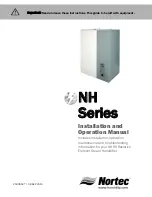
Manual
COMPACT
7
‐
225
Revision
4
E.1
(NL)
WERKINGSPRINCIPE
(ENG)
METHOD
OF
OPERATION
PERSLUCHTKETEN
Raadpleeg
de
figuren
op
pagina
E.5,
E.6
en
E7.
Bij
de
luchtinlaat
heeft
de
binnenkomende
lucht
meestal
een
temperatuur
tussen
de
10
en
15
°C
boven
de
omgevingstemperatuur.
De
ingevoerde
warme
en
vochtige
lucht
wordt
door
de
geïntegreerde
voorkoeler
/
naverwarmer
gevoerd.
Dit
is
een
lucht
/
lucht
warmtewisselaar
waar
de
temperatuur
van
de
lucht
ongeveer
16°C
verlaagd
wordt
door
middel
van
de
reeds
gekoelde
en
gedroogde
uittredende
lucht
met
als
positief
gevolg
dat
de
warmtebelasting
drastisch
verminderd.
Vervolgens
gaat
de
voorgekoelde
lucht
de
lucht
/
koelmiddel
warmtewisselaar
binnen
waar
de
warmtewisseling
gebeurt
tussen
de
warme
lucht
en
het
koude
verdampende
koelmiddel.
Terwijl
de
lucht
door
de
warmtewisselaar
gaat
wordt
de
temperatuur
verlaagd,
zodat
er
waterdamp
wordt
gevormd.
Op
de
uitgang
van
de
warmtewisselaar
zit
een
waterafscheider
met
bijhorende
aftap
waar
het
gevormde
condensaat
automatisch
wordt
afgevoerd.
De
lucht
wordt
dan
door
de
naverwarmer
gevoerd,
waar
de
temperatuur
met
ongeveer
22°C
wordt
verhoogd.
Dit
gebeurt
om
condensaat
op
de
buitenkant
van
het
persluchtleidingnet
te
voorkomen
en
zoals
reeds
eerder
is
uitgelegd,
om
de
warmtebelasting
te
verminderen.
KOELCIRCUIT
De
lucht
/
koelmiddel
warmtewisselaar
die
zich
in
de
platenwarmtewisselaar
bevindt
wordt
gebruikt
als
verdamper
in
het
koelcircuit.
In
deze
warmtewisselaar
wordt
het
koelmiddel
van
de
vloeistoffase
naar
de
dampfase
gebracht.
Deze
toestandsverandering
vraagt
veel
warmte
‐
energie.
De
benodigde
warmte
wordt
onttrokken
aan
de
passerende
warme
lucht
die
hierdoor
zal
afkoelen.
De
damp
die
na
de
verdamper
wordt
opgevangen,
wordt
door
de
compressor
opgezogen
en
gecomprimeerd.
Van
hieruit
gaat
het
koelmiddel
naar
de
condensor
waar
de
toegevoegde
energie
van
het
comprimeren
en
de
thermische
uitwisseling
in
de
vorm
van
warmte
wordt
afgegeven.
Door
deze
warmteafgifte
gaat
de
koelmiddeldamp
condenseren
in
vloeistof
onder
hoge
druk.
De
vloeistof
passeert
een
filter
‐
droger
en
wordt
vervolgens
teruggebracht
in
de
verdamper
waar
het
hele
proces
opnieuw
begint.
De
compressor
wordt
beveiligd
door
een
lage
‐
/
hogedrukschakelaar
op
de
modellen
COM
90
tot
COM
225,
die
bescherming
biedt
in
geval
van
een
te
hoge
thermische
belasting
of
koelmiddellek.
WAARSCHUWING
Modellen
COM
90
t/m
COM
225
zijn
uitgevoerd
met
carterverwarming.
COMPRESSED
AIR
CIRCUIT
Refer
to
figures
on
pages
E.5,
E.6
and
E.7.
At
the
air
intake,
air
enters
the
dryer
at
a
temperature
of
usually
between
10
‐
15
°C
above
ambient.
The
incoming
hot
moist
air
is
passed
through
the
integrated
precooler/reheater.
This
is
an
air
‐
to
‐
air
heat
exchanger
in
which
the
air
is
cooled
by
about
16°C
by
cooled
dried
air.
The
advantage
is
that
the
heat
load
can
be
drastically
reduced.
Subsequently
the
precooler
air
enters
the
air/coolant
heat
exchanger
where
the
heat
exchange
takes
place
between
the
hot
air
and
the
cold
evaporating
coolant.
When
air
passes
through
the
heat
exchanger
its
temperature
falls
with
the
result
that
the
water
vapour
it
contains
condenses.
A
water
separator
is
provided
on
the
heat
exchanger
outlet.
This
is
provided
with
a
drain
which
allows
the
condensed
water
to
be
automatically
drained
off.
The
air
is
then
passed
through
the
reheater
where
its
temperature
is
raised
about
22°C.
This
is
done
to
prevent
sweating
on
the
external
surfaces
of
the
compressed
air
pipe
‐
work
and
as
already
explained
to
reduce
the
incoming
heat
load.
REFRIGERATION
CIRCUIT
The
air
/coolant
heat
exchanger
located
in
the
plate
heat
exchanger
serves
as
the
evaporator
of
the
cooling
circuit.
The
coolant
in
this
heat
exchanger
is
transformed
from
the
liquid
phase
to
the
gas
phase.
The
phase
change
requires
large
amounts
of
heat
energy.
The
required
heat
is
drawn
from
the
warm
air
passing
through
the
heat
exchanger,
which
cools
down
as
a
result.
The
vapour
collected
after
the
evaporator
is
pulled
into
the
suction
side
of
the
compressor,
and
is
then
compressed.
The
coolant
then
passes
on
to
a
condenser
where
the
absorbed
heat
energy
and
the
energy
arising
from
the
compression
process
is
surrendered
in
the
form
of
heat.
The
cooling
causes
the
refrigerant
to
condense
thus
producing
a
high
pressure
liquid.
The
liquid
is
filtered
and
dried
and
is
then
ready
to
be
re
‐
injected
back
into
the
evaporator
where
the
whole
process
would
start
again.
The
compressor
is
protected
by
a
high
pressure
cut
out
and
a
low
pressure
cut
out
on
COM
90
up
to
COM
225,
which
will
offer
protection
in
the
event
of
high
thermal
load
or
loss
of
refrigerant.
WARNING
Crankcase
heaters
are
fitted
on
COM
90
through
COM
225.
VERWIJDER
DE
SMELTPATRONEN
VAN
DE
CARTERVERWARMING
VOORDAT
MEN
MET
ONDERHOUDS
‐
/
REPARATIEWERKZAAMHEDEN
BEGINT.
!
REMOVE
CRANKCASE
HEATER
FUSES
PRIOR
TO
SERVICE.
!















































